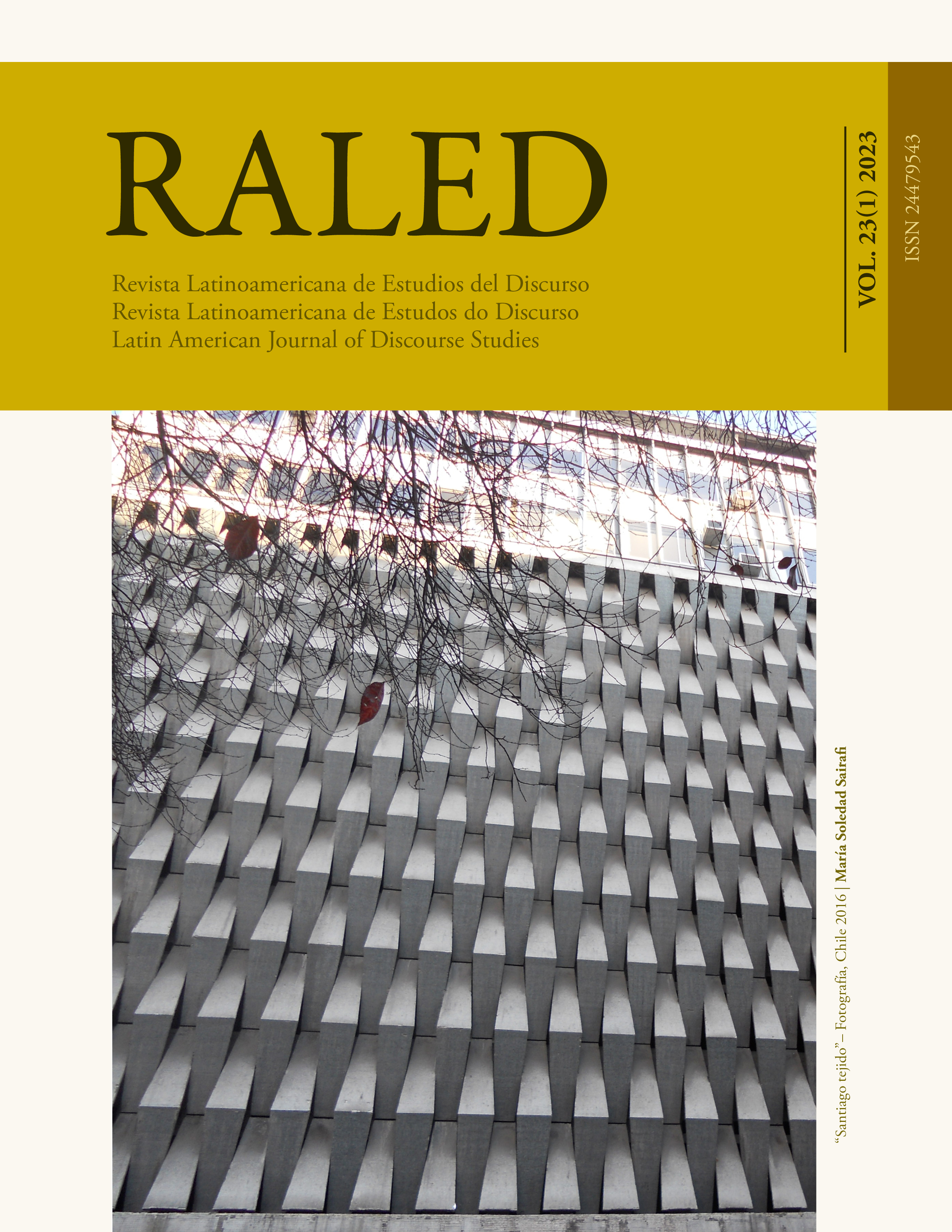El posicionamiento de la expresidenta argentina Cristina Fernández con respecto al discurso dominante sobre migrantes: refuerzos, disputas y vacíos
DOI:
https://doi.org/10.35956/v.23.n1.2023.p.71-92Keywords:
Migrantes. Discurso político. Discurso dominante. Representaciones sociales. Kirchnerismo.Abstract
This paper aims to analyze social representations that former president of Argentina, Cristina Fernández, builds referred to migrants during her first year in office. Our working hypothesis states that, although she activates the framework of crime -proper of the dominant discourse in Argentina- in relation to foreigners, in doing so, she introduces some innovations. In particular, she seeks to naturalize their presence and rejects the xenophobic policies of the European Union. We inscribe our research in Critical Discourse Analysis and our analytical device is integrated by a series of methodological tools consistent with their postulates, which combined enable us to account for the social representations present in the analyzed texts: 1) processes and participants, 2) frames and conceptual metaphors 3) evaluation.
Downloads
References
Chilton, P. 2011. Still something missing in CDA. Discourse Studies 13, 6: 769-781.
Chilton, P. 2014. Language, Space and Mind: The Conceptual Geometry of Linguistic Meaning. Cambridge: Cambridge University Press.
Domenech, E. 2015. Inmigración, anarquismo y deportación: la criminalización de los extranjeros “indeseables” en tiempos de las “grandes migraciones”. REMHU 23, 45: 169-196.
Fairclough, N. 2003. Analysing Discourse. Textual Analysis for Social Research. London: Routledge.
Fairclough, N. 2014. Language and Power. London: Routledge.
Fillmore, C. 1982. Frame Semantics. En Linguistic Society of Korea (Ed.). Linguistics in the Morning Calm, pp. 11-38. Seoul: Hanshin.
Flax, R. 2019. La criminalización de la inmigrante en el decreto 70/2017: un aporte desde el análisis del discurso. Revista de Lingüística Aplicada 57, 1: 181-201.
Flax, R. 2020a. Acerca de las dificultades de ser políticamente correcta: el discurso de Cristina Fernández sobre les migrantes. Revista Refracción 1: 35-61.
Flax, R. 2020b. Representaciones sobre migrantes en Argentina durante la presidencia de Cristina Fernández: ¿una posible alternativa al discurso dominante? Revista Lengua y migración 2, 2: 91-111.
Fowler, R., Hodge, R., Kress, G., y Trew, T. 1983. Lenguaje y control. México: Fondo de cultura económica.
Gasparri, J. 2020. Acerca del lenguaje inclusivo: cuestiones teóricas, razones políticas. En S. Kalinowski, J. Gasparri, S. Pérez y F. Moragas (Eds.). Apuntes sobre lenguaje no sexista e inclusivo, pp. 31-68. Rosario: UNR Editora.
Grupo de Estudios en Antropología y Discurso (Geadis). 2002. De inmigrantes a delincuentes. La reducción de los indocumentados como amenaza social en el discurso policial. Cuadernos de Antropología Social 15: 91-109.
Golay, I. 2013. Argentina ‘crisol de razas’: ficción y realidad. Actas de las VII Jornadas de Jóvenes Investigadores. http://jornadasjovenesiigg.sociales.uba.ar/wp-content/uploads/sites/107/2013/10/eje1_Golay.pdf
Hart, C. 2010. Critical Discourse Analysis and Cognitive Science New Perspectives on Immigration Discourse. London: Palgrave Macmillan.
Hart, C. 2014. Discourse, Grammar and Ideology. London: Bloomsbury.
Hodge, R. y Kress, G. 1993. Language as Ideology. London: Routledge & Kegan Paul Books.
Kaplan, N. 2004. Nuevos desarrollos en el estudio de la evaluación en el lenguaje: la teoría de la valoración. Boletín de Lingüística 22: 52-78. http://saber.ucv.ve/ojs/index.php/rev_bl/article/view/1468
Lakoff, G. 1987. Women, Fire and Dangerous Things. Chicago/London: University of Chicago Press.
Lakoff, G. 2010. Why it Matters How We Frame the Environment. Environmental Communication 4, 1: 70-81.
Lakoff, G. y Johnson, M. 2003. Metaphors we live by. Chicago/London: The University of Chicago press.
Martin, J. y White, P. 2005. The language of evaluation. Appraisal in English. New York: Palgrave Macmillan.
Martín Rojo, L. 1997. El orden social de los discursos. Revista Discurso 21, 22: 1-37.
Melella, C. 2015. Migraciones latinoamericanas y prensa gráfica. Análisis comparativo entre
Argentina y España. Odisea. Revista de Estudios Migratorios 2: 157-186.
ONU. 2013. [Disponible en: www.un.org/en/development/desa/population/migration/data/index.asp] International migrant stock 2013: Total. [Consulta: 23 de marzo de 2022].
Perera, M. y Velázquez, C. 2013. Impacto del programa de regularización migratoria ‘Patria grande’ en Argentina. Estudios Económicos 30, 61: 43-69.
Raiter, A. 2003. Lenguaje y sentido común. Las bases para la formación del discurso dominante. Buenos Aires: Biblos.
Raiter, A y Zullo, J. 2008. Lingüística y Política. Buenos Aires: Editorial Biblos.
Romero, C. y Funes, S. 2018. Nuevas conceptualizaciones de género en el español de la
argentina: un análisis cognitivo-prototípico. RASAL 7-39.
Torres, V. 2013. Cambios en la estructura sociodemográfica de los migrantes limítrofes de la última década en argentina. un aporte metodológico. Revista Astrolabio 11: 311-333.
Van Dijk, T. 1998. Ideology: A Multidisciplinary Approach. London: Sage.
Downloads
Published
How to Cite
Issue
Section
License
Copyright (c) 2023 Rocío Flax

This work is licensed under a Creative Commons Attribution-NonCommercial-NoDerivatives 4.0 International License.
The authors retain the copyright and guarantee RALED the right to be the first publication of the work as well as a Creative Commons Attribution License that allows others to share the work with recognition of authorship and the initial publication in this journal.




